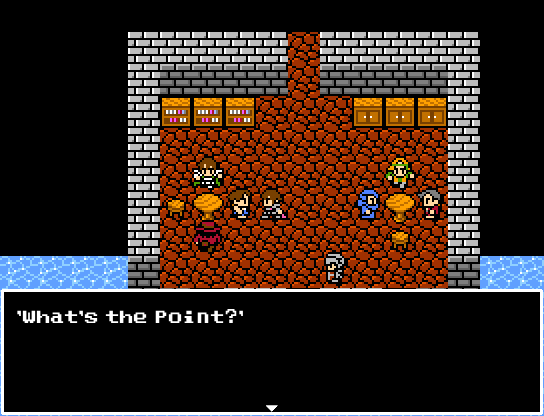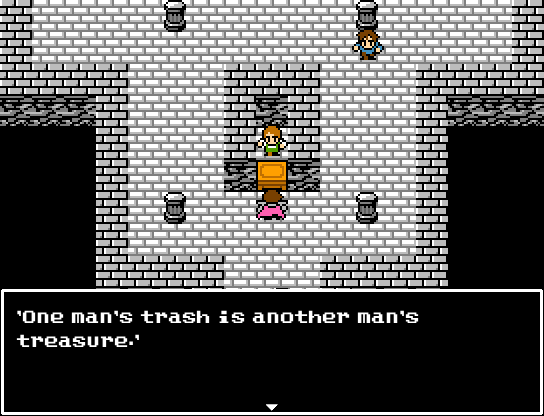
1. I like that Artifact Adventure refuses to copy classes from other RPGs. You get that exciting moment of wonder: "What can they do? How are they different from each other? What's new about them?" I'm less excited that they map cleanly to the Final Fantasy classes: Warrior = Fighter, Hermit = Thief, Shaman = Black Mage, Explorer = Red Mage, Monk = Black Belt. Though that may be necessity of the form; how many ways can you configure the two qualities Good At Attack and Good At Magic? At least the Dreamer is new.
2. There's no equivalent to the White Mage. In fact, for as long as I've played there doesn't appear to be any healing magic at all. This is interesting. In many RPGs where the battle economy is balanced around how long you can survive on a fixed pool of MP (as opposed to RPGs where the economy is a meaningless sludge) a single delve into the dungeon can last for a long time. MP converts to HP at a very favorable exchange rate. But here, instead, every little papercut hurts because it shortens the distance you can delve directly. It makes more explicit the usually-latent risk/reward of pushing on vs returning to rest. And it means enemies are dangerous even when they don't do much damage because you fear that they do damage at all.
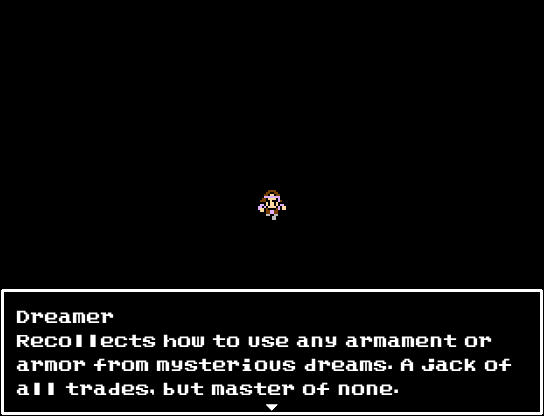
3. The Swamp King is evil and lives in the swamp. And is a king, presumably. A typical videogame enigma-antagonist. He's poisoning the land, supposedly (though we never see any evidence of this), and that's bad, so you must hate him and kill him. You only hear about him from the perspective of the (non-Swamp) king and his soldiers. Maybe it's all slander? Normally I wouldn't be too optimistic about the potential third-act twist here, but something about the game makes me wonder...
4. I resent the symmetry of some of the buildings in this game; they're disorienting. Real spaces don't look like that, not really, there's always some kind of flaw that makes them both more human and more navigable. When you end up in something like a generic concrete emergency stairwell more often than not a human has put up a sign so you don't become completely placeless, even if it just says "North Stairwell" or whatever.
5. At first I thought the bushes and trees would have different (harder) encounters than the grass, so I avoided them. But after some experimentation, I don't think that's true. They just seem to be there to expand the navigable area, to make it look more like a world and less like aliased blobs of random encounter regions. There's not really a point to walking to a lot of the places in the game, unless you're lost. So then the only purpose of the trees is to trick you into playing suboptimally. I guess that's true of a lot of video games.
I later learned that in the Dragon Quest series, from which this game has heavily borrowed, the bushes and trees have a higher encounter rate. I'm not interested in verifying that Artifact Adventure's bushes and trees behave the same way, but it would make them slightly less pointless.
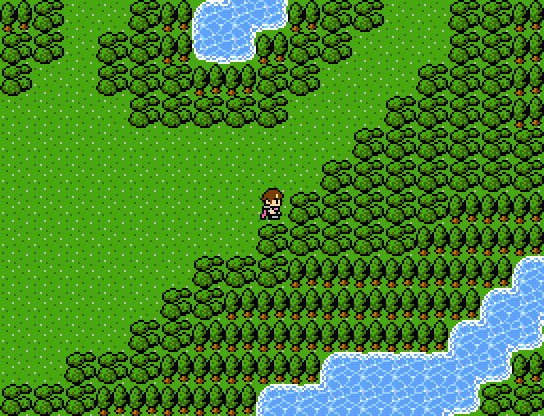
6. I find myself walking up to random objects and pressing Z and hoping something will happen. Usually nothing does. I guess I'm the kind of designer that likes to reward you for doing pointless nonsense, but it raises the question of what the game would award, hypothetically. You can't make it (whatever it is) too powerful because that would create a gulf between the pointless-nonsense-doers and everyone else, and you can't have it trigger anything important or most people won't see it. I like the Jar Goblins as a solution to this: collect enough and you get something useful, with no expectation you'll collect them all.
7. The NPC dialog is either obviously ironic ("People say one of the towers that grants power to the Swamp King is in the southern forests.") or firmly inane ("No problems here!"). This is okay, but I do wish it were a little weirder. Even Final Fantasy has lines like "See your face upon the clean water. How dirty! Come! Wash your face!"
8. I love the house of failed adventurers, south of the starting castle. It makes the player's default feeling of inevitable victory a little more complicated. No one in this world expects you to succeed. You're just another iteration in a long line of failures.
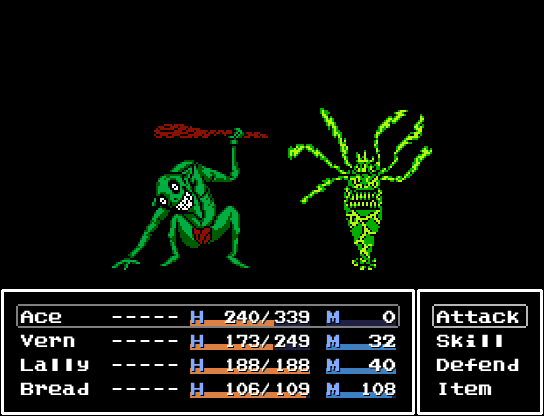
9. Starting to feel some malaise as the world opens up. I have a to-do list now. The early stages of RPGs are always scary and confusing, and are generally the most interesting feelings they evoke (outside of strictly narrative proceedings, like dialog). What am I supposed to do? What do all these items do? If I wander across this bridge will the monsters eat me? But once you reach a certain character power level and literacy of the systems you are rarely in danger any more, since any challenge can be countered by grinding easier areas. Fortunately, Artifact Adventure puts some effort into its dungeon design and tries to surprise you with too-powerful enemies often enough to keep you guessing.
10. Maybe the thing I appreciate most is that it's not trying to tell a story. Games are very bad at telling a story; when they do they must switch to linear prose or cinema. So you the game designer have two choices: you can tell a non-story, or you can not tell a story at all. Artifact Adventure does the latter. You're free to wander around this little fantasy playground and fight monsters and see the tiny stories of the world's inhabitants without needing to go to certain places or activate certain plot points or do anything in particular. That's very freeing.
